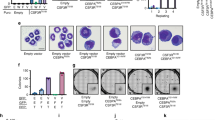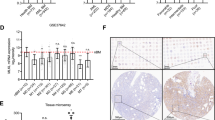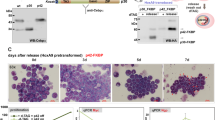Abstract
Cytokine signaling pathways are frequent targets of oncogenic mutations in acute myeloid leukemia (AML), promoting proliferation and survival. We have previously shown that the transcription factor PLAGL2 promotes proliferation and cooperates with the leukemia fusion protein Cbfβ-SMMHC in AML development. Here, we show that PLAGL2 upregulates expression of the thrombopoietin receptor Mpl, using two consensus sites in its proximal promoter. We also show that Mpl overexpression efficiently cooperates with Cbfβ-SMMHC in development of leukemia in mice. Finally, we demonstrate that PlagL2-expressing leukemic cells show hyper-activation of Jak2 and downstream STAT5, Akt and Erk1/2 pathways in response to Thpo ligand. These results show that PlagL2 expression activates expression of Mpl in hematopoietic progenitors, and that upregulation of wild-type Mpl provides an oncogenic signal in cooperation with CBFβ-SMMHC in mice.
This is a preview of subscription content, access via your institution
Access options
Subscribe to this journal
Receive 12 print issues and online access
$259.00 per year
only $21.58 per issue
Buy this article
- Purchase on Springer Link
- Instant access to full article PDF
Prices may be subject to local taxes which are calculated during checkout




Similar content being viewed by others
References
Look AT . Oncogenic transcription factors in the human acute leukemias. Science 1997; 278: 1059–1064.
Castilla LH, Wijmenga C, Wang Q, Stacy T, Speck NA, Eckhaus M et al. Failure of embryonic hematopoiesis and lethal hemorrhages in mouse embryos heterozygous for a knocked-in leukemia gene CBFB-MYH11. Cell 1996; 87: 687–696.
Kuo YH, Landrette SF, Heilman SA, Perrat PN, Garrett L, Liu PP et al. Cbf beta-SMMHC induces distinct abnormal myeloid progenitors able to develop acute myeloid leukemia. Cancer Cell 2006; 9: 57–68.
Boissel N, Leroy H, Brethon B, Philippe N, de Botton S, Auvrignon A et al. Incidence and prognostic impact of c-Kit, FLT3, and Ras gene mutations in core binding factor acute myeloid leukemia (CBF-AML). Leukemia 2006; 20: 965–970.
Care RS, Valk PJ, Goodeve AC, Abu-Duhier FM, Geertsma-Kleinekoort WM, Wilson GA et al. Incidence and prognosis of c-KIT and FLT3 mutations in core binding factor (CBF) acute myeloid leukaemias. Br J Haematol 2003; 121: 775–777.
Schessl C, Rawat VP, Cusan M, Deshpande A, Kohl TM, Rosten PM et al. The AML1-ETO fusion gene and the FLT3 length mutation collaborate in inducing acute leukemia in mice. J Clin Invest 2005; 115: 2159–2168.
Valk PJ, Verhaak RG, Beijen MA, Erpelinck CA, Barjesteh van Waalwijk van Doorn-Khosrovani S, Boer JM et al. Prognostically useful gene-expression profiles in acute myeloid leukemia. N Engl J Med 2004; 350: 1617–1628.
Speck NA, Gilliland DG . Core-binding factors in haematopoiesis and leukaemia. Nat Rev Cancer 2002; 2: 502–513.
Castilla LH, Perrat P, Martinez NJ, Landrette SF, Keys R, Oikemus S et al. Identification of genes that synergize with Cbfb-MYH11 in the pathogenesis of acute myeloid leukemia. Proc Natl Acad Sci USA 2004; 101: 4924–4929.
Landrette SF, Kuo YH, Hensen K, Barjesteh van Waalwijk van Doorn-Khosrovani S, Perrat PN, Van de Ven WJ et al. Plag1 and Plagl2 are oncogenes that induce acute myeloid leukemia in cooperation with Cbfb-MYH11. Blood 2005; 105: 2900–2907.
Voz ML, Agten NS, Van de Ven WJ, Kas K . PLAG1, the main translocation target in pleomorphic adenoma of the salivary glands, is a positive regulator of IGF-II. Cancer Res 2000; 60: 106–113.
Declercq J, Skaland I, Van Dyck F, Janssen EA, Baak JP, Drijkoningen M et al. Adenomyoepitheliomatous lesions of the mammary glands in transgenic mice with targeted PLAG1 overexpression. Int J Cancer 2008; 123: 1593–1600.
Kas K, Voz ML, Roijer E, Astrom AK, Meyen E, Stenman G et al. Promoter swapping between the genes for a novel zinc finger protein and beta-catenin in pleiomorphic adenomas with t(3;8)(p21;q12) translocations. Nat Genet 1997; 15: 170–174.
Pallasch CP, Patz M, Park YJ, Hagist S, Eggle D, Claus R et al. miRNA deregulation by epigenetic silencing disrupts suppression of the oncogene PLAG1 in chronic lymphocytic leukemia. Blood 2009; 114: 3255–3264.
Kuhn R, Schwenk F, Aguet M, Rajewsky K . Inducible gene targeting in mice. Science 1995; 269: 1427–1429.
Javed A, Zaidi SK, Gutierrez SE, Lengner CJ, Harrington KS, Hovhannisyan H et al. Protein-deoxyribonucleic acid interactions linked to gene expression: electrophoretic mobility shift assay. Methods Mol Biol 2004; 285: 45–55.
Hensen K, Van Valckenborgh IC, Kas K, Van de Ven WJ, Voz ML . The tumorigenic diversity of the three PLAG family members is associated with different DNA binding capacities. Cancer Res 2002; 62: 1510–1517.
Kas K, Voz ML, Hensen K, Meyen E, Van de Ven WJ . Transcriptional activation capacity of the novel PLAG family of zinc finger proteins. J Biol Chem 1998; 273: 23026–23032.
Castilla LH, Garrett L, Adya N, Orlic D, Dutra A, Anderson S et al. The fusion gene Cbfb-MYH11 blocks myeloid differentiation and predisposes mice to acute myelomonocytic leukaemia. Nat Genet 1999; 23: 144–146.
Challier C, Cocault L, Flon M, Pauchard M, Porteu F, Gisselbrecht S et al. A new feature of Mpl receptor: ligand-induced transforming activity in FRE rat fibroblasts. Oncogene 2000; 19: 2033–2042.
Bouscary D, Lecoq-Lafon C, Chretien S, Zompi S, Fichelson S, Muller O et al. Role of Gab proteins in phosphatidylinositol 3-kinase activation by thrombopoietin (Tpo). Oncogene 2001; 20: 2197–2204.
Drachman JG, Griffin JD, Kaushansky K . The c-Mpl ligand (thrombopoietin) stimulates tyrosine phosphorylation of Jak2, Shc, and c-Mpl. J Biol Chem 1995; 270: 4979–4982.
Kaushansky K . Lineage-specific hematopoietic growth factors. N Engl J Med 2006; 354: 2034–2045.
Voz ML, Mathys J, Hensen K, Pendeville H, Van Valckenborgh I, Van Huffel C et al. Microarray screening for target genes of the proto-oncogene PLAG1. Oncogene 2004; 23: 179–191.
Kondo T, Okabe M, Sanada M, Kurosawa M, Suzuki S, Kobayashi M et al. Familial essential thrombocythemia associated with one-base deletion in the 5′-untranslated region of the thrombopoietin gene. Blood 1998; 92: 1091–1096.
Ding J, Komatsu H, Wakita A, Kato-Uranishi M, Ito M, Satoh A et al. Familial essential thrombocythemia associated with a dominant-positive activating mutation of the c-MPL gene, which encodes for the receptor for thrombopoietin. Blood 2004; 103: 4198–4200.
Pardanani AD, Levine RL, Lasho T, Pikman Y, Mesa RA, Wadleigh M et al. MPL515 mutations in myeloproliferative and other myeloid disorders: a study of 1182 patients. Blood 2006; 108: 3472–3476.
Pikman Y, Lee BH, Mercher T, McDowell E, Ebert BL, Gozo M et al. MPLW515L is a novel somatic activating mutation in myelofibrosis with myeloid metaplasia. PLoS Med 2006; 3: e270.
Deveaux S, Filipe A, Lemarchandel V, Ghysdael J, Romeo PH, Mignotte V . Analysis of the thrombopoietin receptor (MPL) promoter implicates GATA and Ets proteins in the coregulation of megakaryocyte-specific genes. Blood 1996; 87: 4678–4685.
Huang H, Yu M, Akie TE, Moran TB, Woo AJ, Tu N et al. Differentiation-dependent interactions between RUNX-1 and FLI-1 during megakaryocyte development. Mol Cell Biol 2009; 29: 4103–4115.
Jackers P, Szalai G, Moussa O, Watson DK . Ets-dependent regulation of target gene expression during megakaryopoiesis. J Biol Chem 2004; 279: 52183–52190.
Alexander WS, Roberts AW, Nicola NA, Li R, Metcalf D . Deficiencies in progenitor cells of multiple hematopoietic lineages and defective megakaryocytopoiesis in mice lacking the thrombopoietic receptor c-Mpl. Blood 1996; 87: 2162–2170.
Kimura S, Roberts AW, Metcalf D, Alexander WS . Hematopoietic stem cell deficiencies in mice lacking c-Mpl, the receptor for thrombopoietin. Proc Natl Acad Sci USA 1998; 95: 1195–1200.
Yoshihara H, Arai F, Hosokawa K, Hagiwara T, Takubo K, Nakamura Y et al. Thrombopoietin/MPL signaling regulates hematopoietic stem cell quiescence and interaction with the osteoblastic niche. Cell Stem Cell 2007; 1: 685–697.
Abdollahi A . LOT1 (ZAC1/PLAGL1) and its family members: mechanisms and functions. J Cell Physiol 2007; 210: 16–25.
Valleley EM, Cordery SF, Carr IM, MacLennan KA, Bonthron DT . Loss of expression of ZAC/PLAGL1 in diffuse large B-cell lymphoma is independent of promoter hypermethylation. Genes Chromosomes Cancer 2010; 49: 480–486.
Acknowledgements
We thank Julie Zhu and Stephen Baker for the statistical analyses of the expression data. This work was supported by National Institutes of Health Grant CA09683 to LHC, and Core resources were supported by the Diabetes Endocrinology Research Center Grant DK32520. LHC is recipient of a Scholar Award from the Leukemia and Lymphoma Society.
Author information
Authors and Affiliations
Corresponding author
Ethics declarations
Competing interests
The authors declare no conflict of interest.
Additional information
Supplementary Information accompanies the paper on the Leukemia website
Rights and permissions
About this article
Cite this article
Landrette, S., Madera, D., He, F. et al. The transcription factor PlagL2 activates Mpl transcription and signaling in hematopoietic progenitor and leukemia cells. Leukemia 25, 655–662 (2011). https://doi.org/10.1038/leu.2010.301
Received:
Revised:
Accepted:
Published:
Issue Date:
DOI: https://doi.org/10.1038/leu.2010.301
Keywords
This article is cited by
-
PLAGL1 is associated with prognosis and cell proliferation in pancreatic adenocarcinoma
BMC Gastroenterology (2023)
-
PLAGL2 promotes bladder cancer progression via RACGAP1/RhoA GTPase/YAP1 signaling
Cell Death & Disease (2023)
-
Amplification of the PLAG-family genes—PLAGL1 and PLAGL2—is a key feature of the novel tumor type CNS embryonal tumor with PLAGL amplification
Acta Neuropathologica (2023)
-
Ubiquitin-specific peptidase 37: an important cog in the oncogenic machinery of cancerous cells
Journal of Experimental & Clinical Cancer Research (2021)
-
The PLAGL2/MYCN/miR-506-3p interplay regulates neuroblastoma cell fate and associates with neuroblastoma progression
Journal of Experimental & Clinical Cancer Research (2020)



